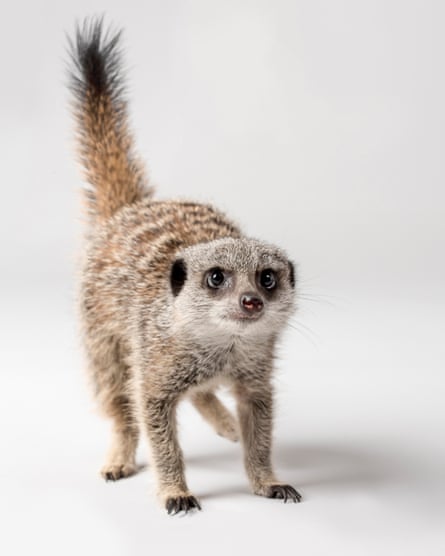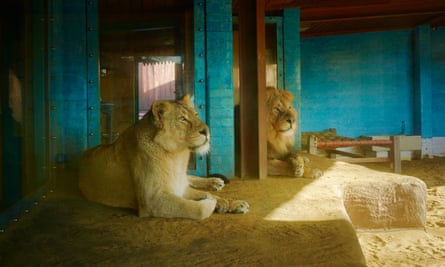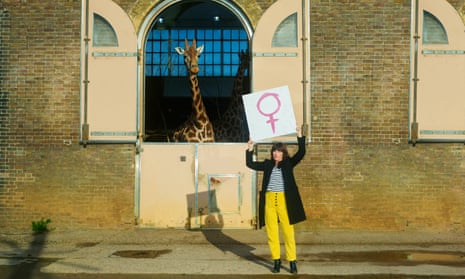London Zoo at half-term is a cheerful cacophony with blue macaws out-screaming six-year-olds, but in the relative calm of the lush spider “walkthrough” exhibit (apologies, arachnophobes), Lucy Cooke is happily absorbed. “Let’s see if we can see a big predatory female,” she says. We can: a gorgeously colourful golden orb weaver sits in the centre of her vast gold-tinted web, 125 times bigger than her tiny mate. “I didn’t realise that the majority of spiders are sexual cannibals, that the big spiders in the middle of webs were always female; males are basically wandering useless sacks of sperm,” Cooke says loudly in earshot of several harried-looking human fathers.
This is a very Lucy Cooke observation: uncensored, pithily expressed and startlingly informative. There is plenty more of that in her new book, Bitch: A Revolutionary Guide to Sex, Evolution & the Female Animal, a dazzling, funny and elegantly angry demolition of our preconceptions about female behaviour and sex in the animal kingdom (queendom?).
For too long, Cooke argues, we have uncritically accepted a view of nature “through a Victorian pinhole camera” and worse, those misconceptions have been co-opted by ideologues “to claim that a host of grim male behaviours – from rape to compulsive skirt-chasing to male supremacy – were only natural for humans because Darwin said so.” That is simply, demonstrably wrong, as she outlines, combining colourful revelations with limpidly clear explanations of complex science. “Female animals,” she writes, “are just as promiscuous, competitive, aggressive, dominant and dynamic as males.”
Bitch is a blast. I read it, my jaw sagging in astonishment, jotting down favourite parts to send to friends and reading out snippets gleefully to my male housemates for days. I don’t want to spoil it for you, but just a taster: spotted hyenas have eight-inch clitorises which get erections and female moles have “ovo-testes”, albatrosses can form lasting lesbian partnerships, all-female whiptail lizards reproduce asexually but engage in gender-fluid role play, and ducks have spiral-shaped vaginas, probably to evade forced copulation (40% of mallard sex is non-consensual; you’ll never look at your local duckpond in the same way, especially once you read the indelible phrase “The penis explodes out of his cloaca at 75mph, unfurling itself… like some kind of sinewy party hooter.”, which I screenshot and circulate widely) As for bonobos, if this were a podcast, I’d be issuing a content warning for later in the episode.

Back to those mate-eating spiders. They are, if anything, one of the less surprising parts of the book; they fit that “female of the species more deadly than the male” cliché we carry along with all our other cultural baggage. “We have this fascination with the behaviour because it seems so campy and sexy and dangerous, and really, this cannibalistic behaviour is just an example of being assiduously maternal,” Cooke explains, as we search the edge of the web for a male. (“He’ll be looking a bit nervous, possibly bringing some kind of edible gift” – other male spiders use massage, “light bondage” and oral sex to try to stay alive.) “This is something male evolutionary biologists have really struggled with, but that’s because it’s considered from the male perspective; actually, it makes a lot of sense because it means the eggs get the best chance by being nourished as much as possible, including by the father that created them.”
Leaving the spider house (“Look at that web!” she says on the way out. “World’s greatest engineer is bloody female!”), we encounter a gang of squirrel monkeys. This is another female-dominant species, Cooke tells me. “They look cute, but they’re a bunch of bad-ass bitches.” Finally, we try and fail to find the meerkats: Sergei and Aleksandr would not be calling the shots in this murderous matriarchy, and Oleg would probably have been eaten. “I wonder,” she muses, “what they do here to manage the infanticide situation.”
I wanted to see Cooke among the animals because this is her element – well, as close as you can get without trudging through snow to find sage grouse in Yosemite, tracking lemurs through the Madagascar wilderness or scooping whale poo near Seattle, all of which she does in Bitch. She’s very much an adventurer, not just a thinker: her TV work (including Nature’s Boldest Thieves and Ingenious Animals for the BBC) and book research has taken her to 60 countries and remote biological field stations. She has just returned from Tanzania and Rwanda when we meet, where an encounter with mountain gorillas further fuelled a points she makes in Bitch: thatnurture is far from being a solely female characteristic. “They are this classic patriarchal species, males are these terrifying muscular creatures, but what I witnessed is them being incredibly tender with the babies.”

After an outdoorsy childhood in a family of nature lovers, Cooke studied zoology at Oxford under Richard Dawkins. Afterwards, she says, “I wanted to be either an actor or David Attenborough.” Instead, she went into TV and documentary filmmaking, but quit in frustration when no one would let her make a film about the decline in amphibians (“For God’s sake, Lucy, can’t you come back with a story about an animal with a furry face?” one commissioner told her). Cooke spent six months travelling around South America, exploring the story under her own steam: “I was about to turn 40,” she says, “And I was having an unconventional midlife crisis.” In the South American jungle, writing her blog, the Amphibian Avenger, she says, “I’d landed in my happy place and everything made sense.” National Geographic offered her a TV series on the back of the blog and she has rarely been off-screen since, infectiously curious and endlessly delighted by the weirder, less obviously appealing species and behaviours.
All of which makes Cooke the perfect person to tell these myth-busting female-centred stories. What, I ask, surprised her most during her research? It was the most fundamental stuff, she tells me: the genetics. “The fact that the genes that make an ovary or testes, the things that drive you down the male or female pathway, are basically the same genes, just playing a different tune. I couldn’t believe it. This idea of male and female being these distinct genetic entities is complete rubbish. As a species we’re fascinated by dichotomies, we want everything to be black and white, but it just doesn’t work like that. When it comes to sex, anything goes.” I find this section of the book both exhilarating and unexpected; Cooke describes it as a “paradigm shift”. “The Victorian era was all about imposing order on the natural world,” she says, “but now the approach is to embrace the chaos and to realise the infinite possibilities of developmental plasticity.”
Bitch explores this variety and plasticity of sex in gripping detail: the complex and chaotic process of genetic sex determination, parthenogenesis (“virgin” births), gynandromorphy (“half and half” sexual characteristics in a single individual) and sex changes. A biologically accurate Finding Nemo, Cooke writes drily, “would have seen Nemo’s father, Marlin, transition into a female and then start having sex with his son, which might have made for a less popular family film”.
The fact that so little of this science of what it means to be female is known reminds me of Caroline Criado-Perez’s Invisible Women. In animals, too, scientists not interested in the female experience failed to research it, creating a data gap that means we do not get the full picture. Cooke relates how often-female scientists have been fighting for decades to engineer the radical perspective shift that would allow us to see, and understand, the far more complex and less deterministic real story of sex and reproduction.
In particular, Bitch is luminous with affection and admiration for a group of pioneering, now semi-retired professors – “The Broads”, Sarah Blaffer Hrdy, Jeanne Altmann, Mary Jane West-Eberhard and Patricia Gowaty – whose formidable research challenged the Darwinian phallocracy. “If this book makes their work and their names better known, then that’s a great thing,” says Cooke, praising their support and collegiality when she joined them for their annual get-together (“It’s like meeting four Richard Dawkins in one go!”)
There’s a special mention, too, for Patricia Brennan, a trailblazing researcher of vaginal anatomy. “She was sitting on a table literally piled up with a rainbow of animal dildos on her desk and she sat back in her chair and said ‘So many vaginas, so little time’,” Cooke tells me, wonderingly, of her visit to Brennan’s Massachusetts lab.
For all their efforts, and those of the “brilliant young scientists” Cooke also met in her research, the battle against this male-oriented bias continues: “The struggle is real and it’s happening now,” she says. As late as the 1990s, researchers were dismissing hierarchical fighting between female jays as “the avian equivalent of PMS” and Bateman’s Principle, a discredited demonstration of the reproductive advantage of promiscuity for male fruit flies, still appears unchallenged in textbooks, she says.
TV, too, Cooke thinks, still needs to do better. “I ended up screaming at the television,” she says of The Mating Game, a recent BBC documentary on animal reproduction. “This idea that females are completely passive and it’s the males that have all the strategy just gets trotted out again and again. God, can we change the record? How about the strategy of motherhood? That’s as big, if not a bigger drama.” She knows, from her own TV experiences, the appeal of familiar stories – “There’s something cosy about them” – but perpetuating the stereotype of nurturing mother and providing father is simply inaccurate. “The majority of the animal kingdom is not like that: Dad’s eating the babies, Mum’s shagging the neighbours.”
The book is a stinging corrective to anyone seeking to derive ideological comfort or support from conventional portrayals of animal behaviour. “We have this hangover from the [medieval] bestiaries,” Cooke says. “We look to the animal kingdom for moral guidance, we want them to fit these stereotypes, but they don’t.”
She’s scornful of evolutionary psychologists making money trotting out the “Darwinian” theory that males are competitive and aggressive, females are coy and monogamous. “It’s complete bullshit. Using animals as ideological weapons is a dangerous game. You can find whatever you want in the animal kingdom. You could say look at the hamadryas baboon where the males kidnap the females while they’re still adolescent, then use systematic bullying in their harem to keep them oppressed, that’s a model for human behaviour, or you could look at the bonobos and say these females have overthrown the patriarchy through ecstatic same-sex frottage!”
Ah yes, bonobos: these peaceable primates use sex toys, practise oral sex and establish and maintain female-led social structures through “genito-genital rubbing”. That’s entertaining, but it also matters: as Cooke says, it challenges the clichéd narrative on sex roles in primates, our closest animal relatives.
When she isn’t finding new stories to tell, Cooke lives in Hastings with her rescue “jug” (Jack Russell-pug) Kobi; she never wanted children. Like many women, she doesn’t fit the stereotype of female behaviour and says she “felt weird” about that. It was one of the motivating factors in writing Bitch. “My acknowledged cultural bias – I’m writing about cultural bias, but I’m as biased as anybody – is that I wanted to showcase the diversity that exists, so that women would stop feeling pigeonholed; feeling they should be something they’re not. ‘I like sex’, ‘I’ve got a big clit’, ‘I only want to have sex with women’, ‘I’m bad at breastfeeding’… baboon first-time mums struggle with breastfeeding! If like me you haven’t seen your reflection in the animal kingdom, maybe you might see it and think, ‘Oh, I’m not a freak, it’s OK for me to be me. It’s all fucking natural.’”
‘A sexist mythology has been baked into biology’
An extract from Bitch by Lucy Cooke
Studying zoology made me feel like a sad misfit. Not because I loved spiders, enjoyed cutting up dead things I’d found by the side of the road or would gladly root around in animal faeces for clues as to what their owner had eaten. All my fellow students shared the same curious kinks, so there was no shame there. No, the source of my disquiet was my sex. Being female meant just one thing: I was a loser.
“The female is exploited, and the fundamental evolutionary basis for the exploitation is the fact that eggs are larger than sperms,” wrote my college tutor Richard Dawkins in his bestselling evolutionary bible, The Selfish Gene.
According to zoological law, we egg-makers had been betrayed by our bulky gametes. By investing our genetic legacy in a few nutrient-rich ova, rather than millions of mobile sperm, our forebears had pulled the short straw in the primeval lottery of life. Now we were doomed to play second fiddle to the sperm-shooters for all eternity; a feminine footnote to the macho main event.
I was taught that this apparently trivial disparity in our sex cells laid cast-iron biological foundations for sexual inequality. “It is possible to interpret all other differences between the sexes as stemming from this one basic difference,” Dawkins told us. “Female exploitation begins here.”
Male animals led swashbuckling lives of thrusting agency. They fought one another over leadership or possession of females. They shagged around indiscriminately, propelled by a biological imperative to spread their seed far and wide. And they were socially dominant; where males led, females meekly followed. A female’s role was as selfless mother, naturally; as such, maternal efforts were deemed all alike: we had zero competitive edge. Sex was a duty rather than a drive.
And as far as evolution was concerned it was males who drove the bus of change. We females could hop on for a ride thanks to shared DNA, as long as we promised to keep nice and quiet.
As an egg-making student of evolution, I couldn’t see my reflection in this 50s sitcom of sex roles. Was I some kind of female aberration?
The answer, thankfully, is no.
A sexist mythology has been baked into biology, and it distorts the way we perceive female animals. In the natural world female form and role varies wildly to encompass a fascinating spectrum of anatomies and behaviours. Yes, the doting mother is among them, but so is the jacana bird that abandons her eggs and leaves them to a harem of cuckolded males to raise. Females can be faithful, but only 7% of species are sexually monogamous, which leaves a lot of philandering females seeking sex with multiple partners.
Not all animal societies are dominated by males by any means; alpha females have evolved across a variety of classes and their authority ranges from benevolent (bonobos) to brutal (bees). Females can compete with each other as viciously as males: topi antelope engage in fierce battles with huge horns for access to the best males, and meerkat matriarchs are the most murderous mammals on the planet, killing their competitors’ babies and suppressing their reproduction. Then there are the femme fatales: cannibalistic female spiders that consume their lovers as post- or even pre-coital snacks and “lesbian” lizards that have lost the need for males altogether and reproduce solely by cloning.
In the last few decades there has been a revolution in our understanding of what it means to be female, thanks to a new generation of scientists who are helping to redefine not just the female of the species, but the very forces that shape evolution.
Darwin’s theory of sexual selection drove a wedge between the sexes by focusing on our differences; but these differences are greater culturally than they are biologically. Animal characteristics – be they physical or behavioural – are both varied and plastic. They can bend according to a selection’s whim, which makes sex traits fluid and malleable. Rather than predicting a female’s qualities through the crystal ball of her sex, the environment, time and chance all play a significant role in shaping their form. Females and males are, in fact, far more alike than they are different. So much so, it can sometimes be hard knowing where to draw the line.
Bitch: A Revolutionary Guide to Sex, Evolution & the Female Animal (Transworld, £20) is available from guardianbookshop.com at £17.40
